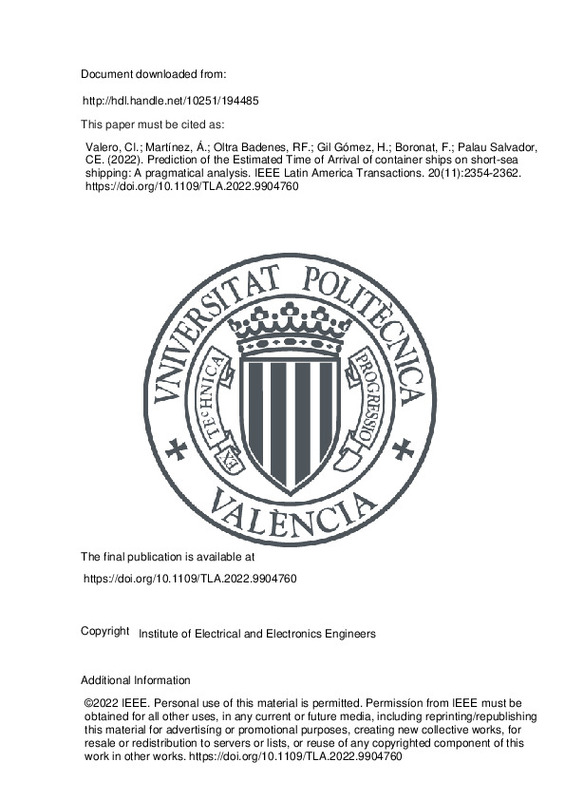Valero, CI.; Martínez, Á.; Oltra Badenes, RF.; Gil Gómez, H.; Boronat, F.; Palau Salvador, CE. (2022). Prediction of the Estimated Time of Arrival of container ships on short-sea shipping: A pragmatical analysis. IEEE Latin America Transactions. 20(11):2354-2362. https://doi.org/10.1109/TLA.2022.9904760
Por favor, use este identificador para citar o enlazar este ítem: http://hdl.handle.net/10251/194485
|
Título:
|
Prediction of the Estimated Time of Arrival of container ships on short-sea shipping: A pragmatical analysis
|
|
Autor:
|

 Valero, Clara I.
Martínez, Ángel
Valero, Clara I.
Martínez, Ángel

 Oltra Badenes, Raúl Francisco
Oltra Badenes, Raúl Francisco

 Gil Gómez, Hermenegildo
Gil Gómez, Hermenegildo

 Boronat, Fernando
Boronat, Fernando
 Palau Salvador, Carlos Enrique
Palau Salvador, Carlos Enrique
|
|
Entidad UPV:
|
Universitat Politècnica de València. Escuela Politécnica Superior de Gandia - Escola Politècnica Superior de Gandia
Universitat Politècnica de València. Escuela Técnica Superior de Ingenieros Industriales - Escola Tècnica Superior d'Enginyers Industrials
Universitat Politècnica de València. Departamento de Comunicaciones - Departament de Comunicacions
Universitat Politècnica de València. Escuela Técnica Superior de Ingenieros de Telecomunicación - Escola Tècnica Superior d'Enginyers de Telecomunicació
|
|
Fecha difusión:
|
|
|
Resumen:
|
[EN] Fighting against climate change and global warming is one of the biggest challenges faced by the Maritime Industry nowadays to make the supply chain greener and environmentally sustainable. Cutting greenhouse gases ...[+]
[EN] Fighting against climate change and global warming is one of the biggest challenges faced by the Maritime Industry nowadays to make the supply chain greener and environmentally sustainable. Cutting greenhouse gases (GHG) emissions and decarbonizing the international shipping has been a paramount activity for the International Maritime Organization (IMO) since the first set of international mandatory measures to improve ships' energy efficiency and reduce CO2 emissions per transport work, as part of the International Convention for the Prevention of Pollution from Ships (MARPOL) released in 2011. Besides that, changes in consumption habits around the globe (i.e., digitalization and growth of e-commerce) plus disruptive events like the COVID-19 or the blocking of the Suez Canal, to name only a few, have also highlighted the need for building more resilient maritime transport networks. In this work, a pragmatical analysis of the principal machine learning algorithms has been carried out to provide a qualitative prediction of the Estimate Time of Arrival (ETA) of container vessels applied to short-sea shipping where the distance between ports is reduced. By exploiting both, the Automatic Identification System (AIS) and meteorological data gathered over a desired area of interest, the developed approach delivers a model capable of predicting the ETA of ships where the reaction time of the stakeholders involved in the management of the Port Call is very reduced (i.e., less than two hours of sailing between ports) and therefore, tolerance for error is low. Very positive results were obtained for the training dataset collected under real conditions for more than a year. The best results were obtained by the RF model with a Mean Absolute Error (MAE) and Root Mean Square Error (RMSE) of 11.31 and 19.56 minutes respectively.
[-]
|
|
Palabras clave:
|
Random forests
,
Artificial intelligence
,
Regression tree analysis
,
Marine vehicles
,
Support vector machines
,
Radio frequency
,
Containers
,
Maritime Logistics
,
Automatic Identification System
,
Estimated Time of Arrival
,
Machine Learning
,
Short-Sea Shipping
,
Green Transition
,
Decarbonization
|
|
Derechos de uso:
|
Reserva de todos los derechos
|
|
Fuente:
|
IEEE Latin America Transactions. (eissn:
1548-0992
)
|
|
DOI:
|
10.1109/TLA.2022.9904760
|
|
Editorial:
|
Institute of Electrical and Electronics Engineers
|
|
Versión del editor:
|
https://doi.org/10.1109/TLA.2022.9904760
|
|
Código del Proyecto:
|
info:eu-repo/grantAgreement/CDTI//EXP 00110912%2FINNO-20181033/
|
|
Descripción:
|
©2022 IEEE. Personal use of this material is permitted. Permissíon from IEEE must be obtained for all other uses, in any current or future media, including reprinting/republishing this material for advertisíng or promotional purposes, creating new collective works, for resale or redistribution to servers or lists, or reuse of any copyrighted component of this work in other works. https://doi.org/10.1109/TLA.2022.9904760
|
|
Agradecimientos:
|
This work has been developed under the framework of the COSIBAS project (funded by CDTI research and innovation programme under grant agreement No.EXP 00110912/INNO20181033).
|
|
Tipo:
|
Artículo
|







![[Cerrado]](/themes/UPV/images/candado.png)


